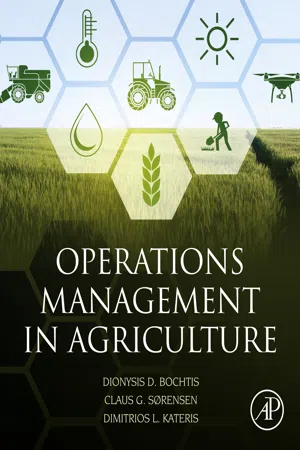
Operations Management in Agriculture
Dionysis Bochtis, Claus Aage Gron Sorensen, Dimitrios Kateris
- 240 pagine
- English
- ePUB (disponibile sull'app)
- Disponibile su iOS e Android
Operations Management in Agriculture
Dionysis Bochtis, Claus Aage Gron Sorensen, Dimitrios Kateris
Informazioni sul libro
Operations Management in Agriculture bridges the knowledge gap on operations management for agricultural machinery. It complements traditional topics (cost of using and choosing machinery) with advanced engineering approaches recently applied in agricultural machinery management (area coverage planning and sequential scheduling). The book covers new technologies in bio-production systems (robotics, IoT) and environmental compliance by employing a systems engineering perspective with focuses on sub-systems, including advanced optimization, supply chain systems, sustainability, autonomous vehicles and IT-driven decision-making. It will be a valuable resource for students studying decision-making and those working to improve the efficiency, effectiveness and sustainability of production through machinery choice.
- Covers agricultural machinery management related courses and a number of other courses within the agricultural engineering discipline
- Provides core tools for machine operations management, including machinery selection and cost of usage
- Presents current knowledge for agricultural machinery management in a science-based format
Domande frequenti
Informazioni
Agricultural Production Through Technological Evolution
Abstract
Keywords
1.1. Key Phases in Agricultural Production Systems


1.1.1. Mechanization Phase (1950–70)
- • increased capacity, and thus increased cropped area
- • reduced time for various operations
- • independence of labor availability and seasonal labor shortages
- • improved working environment and conditions for humans.